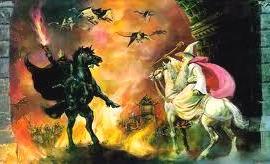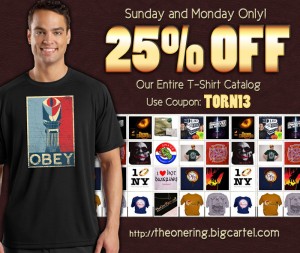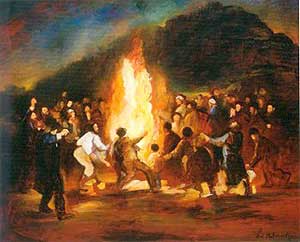October 1999 had some interesting questions from the Tolkien universe…
![]() Q: Hello. I have one, but I’m sure that you’ll get it easy enough. It has become evident to me that me George Lucas used two names for two of the places in Star Wars movies (the first three released). Also, I have a question that I’m hoping you might be able to answer. I have read The Lord of the Rings (sadly) only once. I am 15 and currently working on The Silmarillion, while my friends read my copies of LOTR. I’m having problems with names and locations in The Silmarillion. Is Beleriand the same as Middle-earth? I know that that is a simple question for you, but I frankly have no clue. Any and all help is greatly appreciated. Thank you in advance,
Q: Hello. I have one, but I’m sure that you’ll get it easy enough. It has become evident to me that me George Lucas used two names for two of the places in Star Wars movies (the first three released). Also, I have a question that I’m hoping you might be able to answer. I have read The Lord of the Rings (sadly) only once. I am 15 and currently working on The Silmarillion, while my friends read my copies of LOTR. I’m having problems with names and locations in The Silmarillion. Is Beleriand the same as Middle-earth? I know that that is a simple question for you, but I frankly have no clue. Any and all help is greatly appreciated. Thank you in advance,
–Niles “Dargon” Armstrong
A: Yes, Beleriand was originally created as part of Middle-earth. Technically speaking, the lands of the Valar, or Valinor (a.k.a. “The Undying Lands”), are all found across the sea to the west. Any landmasses on the east of Belegaer, The Great Sea, are considered part of Middle-earth.
In the First Age, the earliest settlements of Elves, Dwarves, Ents, and Men were in Beleriand, which stretched from the coast as far east as the Blue Mountains (Ered Luin). If you look at the map in The Silmarillion you’ll see this mountain range on the furthest east. Now look at any edition of The Lord of the Rings and you’ll see the Ered Luin on the far western edge of the land, bordering the coast.
This is due to the events that brought about the end of the First Age and irrevocably changed the face of the land. During the War of Wrath a great host of Valinor approached the stronghold of Morgoth to destroy him in a final confrontation. When the great towers of Thangorodrim were smashed, the entire continent was thrown into a cataclysm. The breaking of Thangorodrim laid bare the pits of Angband, and the Great Sea engulfed everything. Nearly one million square miles of land were submerged. A new coastline appeared at the Blue Mountains, becoming the more familiar area just west of the Shire where the Grey Havens would be founded centuries later.
So there you are. Beleriand was once truly part of Middle-earth, but the epic and certainly tragic events imagined by Tolkien changed all of it. Belegaer would later be called “The Sundering Sea.”
A while back one reader asked about finding a good map of Númenor. We strongly recommend “The Atlas of Middle-Earth” (1991, Houghton Mifflin) by Karen Wynn Fonstad. For those readers trying to wrap their brain around the many places mentioned in The Silmarillion, take heart! Tremendous light is shed on the material recounted there, and many nebulous things are made clear.
As for your query about George Lucas… who’s he? Never heard of him. The only filmmaker I know of is Peter Jackson.
– Quickbeam
 Q: I’m Portuguese, so I’ve read the Portuguese version of O Hobbit (The Hobbit). In my version, in Chapter 3, on the third page, just before the song, it is written:
Q: I’m Portuguese, so I’ve read the Portuguese version of O Hobbit (The Hobbit). In my version, in Chapter 3, on the third page, just before the song, it is written:
‘Cheira a Elfos,’ pensou Bilbo. —
‘It’s elf smell,’ thought Bilbo, (or something like that).
If Gandalf, or the Dwarves, never mentioned the elves, and when Gandalf, after the troll event, talked about Rivendell and Elrond never saying that there were elves: how did Bilbo know that there were elves? Could he really smell or detect their presence? It’s just an error?
–Ângelo
A: Well, if there’s one thing you really can’t miss a mile off it’s the smell of Elves in the morning. One good whiff will clear up any sinus problem, I guarantee it. But seriously, Ângelo, the translation of your version of The Hobbit is not mistaken. In the original Allen & Unwin edition, the English text says:
‘Hmmm! it smells like elves!’ thought Bilbo, and he looked up at the stars.
And no, there is no earlier mention that Rivendell was a community of elves, or that Bilbo had ever met them. You could easily assume that, like Samwise, our dear Bilbo had never laid eyes on an elf his whole life. But if you look at the next page after the elves complete their song, it says:
He loved elves, though he seldom met them; but he was a little frightened of them too.
And later:
Elves know a lot and are wondrous folk for news, and know what is going on among the peoples of the land, as quick as water flows, or quicker.
So he had seen them in the Shire, probably in the vicinity of Bywater, I would guess, especially if the elven-folk were traveling through on their way to the Havens. We can glean from the above that Bilbo must have had an actual conversation with an Elf, at least once, to learn news of other happenings beyond the Shire’s borders:
As to what they actually smell like? Well, I don’t know. But there are several places in Professor Tolkien’s work where elves and all things elvish are strongly connected to flora and fauna. There are passages that lovingly describe the valley of Rivendell, its fragrant woods and “green pleasant places.” And when the Fellowship arrives in Lórien, great attention is paid to the vibrant plant-life and especially the mallorn trees. Remember Cerin Amroth?
‘Here ever bloom the winter flowers in the unfading grass: the yellow elanor, and the pale niphredil.’
With this literary device, the reader makes a connection with elves and the symbolism of green, living, growing things. Maybe it’s not actually the elves that Bilbo smells, but his memory of fragrant valleys and pine trees is recurrently matched with the fair elven race… and our memory is too.
– Quickbeam
 Q: If Sauron can defeat all his enemies if he has the power of the Ring, why on earth did he make such a blatant tactical error and put a lot of that power into something which can be taken from him?
Q: If Sauron can defeat all his enemies if he has the power of the Ring, why on earth did he make such a blatant tactical error and put a lot of that power into something which can be taken from him?
–Nebel
A: The most obvious answer is that without the existence of the Ring, Sauron would not have a reliable method of controlling the other rings (especially the Elven rings) and, through them, their wearers and their actions. Sauron’s power in the Ring is different from what it would be outside the Ring. Outside the Ring (with his full power restored to himself), Sauron is a mighty spirit with far sight and great power, but he still has to defeat his enemies the old-fashioned ways: trickery and war. He tricked the Men of Númenor into listening to him until they were under his sway; then later, he tricked the Elves of Hollin into listening to him until they showed him all they knew about ring-making. You can’t control other people unless you have soldiers with weapons around to kill or make an example of any that don’t obey, so despite the power of a Maiar, Sauron would have had no actual control over others without war. It’s a chain: Sauron controls a few by threats or promises of reward, who then turn around and do Sauron’s dirty work in controlling others for him. Same thing with Saruman: he had the power of a Maiar, but had to have a bunch of other creatures around to do his dirty work. But Sauron coveted not only control over other peoples but over their works and powers and lands, as well. Tolkien never spells out what all the Three Rings were capable of, but he gives the impression that many of the special qualities of Rivendell and Lothlórien were created and maintained by the power of the Elven rings. Sauron never touched those, but he learned all about their forging and actually helped in the forging of the Seven and the Nine, so that he learned all about the power that was imbued in all the rings, giving him the knowledge needed to make a Ring that would control all the others, control their wearers and their creations. However, the power in this Ring, the power to control the others, had to come from somewhere. So Sauron put a great deal of his own will and power into the forging, transforming his power into a specific channel: that of controlling the other Rings. He assumed he could always keep this Ring with him, thereby having access to all of his power AND controlling the other rings. I guess he didn’t reckon on the Last Alliance. =)
– Anwyn
![]() Q: What are the Barrow Wights? We are never really given a clear description of them (at least as far as I could figure out). It almost seems like the sort of thing that we should have prior knowledge of, but this is the only place I’ve ever seen them.
Q: What are the Barrow Wights? We are never really given a clear description of them (at least as far as I could figure out). It almost seems like the sort of thing that we should have prior knowledge of, but this is the only place I’ve ever seen them.
This was the major mystery that I was left with after finishing the series.
–Terry O’Briant
A: First let us examine the etymology of the actual word, Barrow Wight. My fellow Green Books staffperson Turgon (who is held high among the Wise) shared the following with me:
A barrow is an earthmound marking a grave (from Middle English “berw,” Anglo-Saxon “beorg”). But “wight” is also an archaic word, meaning 1) a human being, or 2) a preternatural or supernatural being. It derives from Middle English “wight” and Anglo-Saxon “wiht,” meaning “creature, animal, person, thing.” So of course the terms have a perfect resonance for Tolkien’s use of them…
Put the two together and you have “supernatural creature of the grave.” This is a shining example of Professor Tolkien’s erudition with these ancient languages.
The Barrow-downs were, as you know, dome-shaped hills crowned with monoliths and ringed with white stones. But we need to look closely at the history of the surrounding lands, as it yields more lucid information about the nefarious Barrow Wights. I will try to keep this “history lesson” as succinct as possible, for there is much to tell. What follows is most germane to your question:
Early in the Third Age, the race of Men (the Dúnedain) held power in two main Kingdoms, Arnor and Gondor. In the north, Arnor was split into three principalities: 1) Arthedain, 2) Rhudaur, and 3) Cardolan. This triad of the Dúnedain had a capital city at Annúminas (and later Fornost). There was constant strife between them and the Witch-King of Angmar, who reigned from his cold seat in Carn Dûm.
The power of the Witch-King was undoubtedly great–he was chief of the Nazgûl, after all. He took into his service Hillmen of the North, and a variety of Orcs and other foul creatures. Not the least of which were the demonic spirits that would eventually become the Barrow Wights, but I’ll get to that in a minute.
Many battles were fought over the centuries between the Dúnedain and the Witch-King, and Elrond himself makes mention of them during the high Council in The Fellowship of the Ring:
“In the North … the Men of Westernesse were diminished, and their city of Annúminas beside Lake Evendim fell into ruin; and the heirs of Valandil removed and dwelt at Fornost on the high North Downs, and that now too is desolate. … For the folk of Arnor dwindled, and their foes devoured them, and their lordship passed, leaving only green mounds in the grassy hills.”
Those ‘green mounds’ he speaks of are the burial mounds the four hobbits passed through only a few chapters earlier. The men of Cardolan used the fields of Tyrn Gorthad (the Barrow-downs) as a refuge and also as a burial field for their fallen kings and warriors. The white monoliths marked the gravesites of many of the fallen.
When the Witch-King was ultimately defeated, he fled into the shadows of dusk and vanished from the north. Many tortured servants and spirits also fled from Angmar after his power was broken, no longer having their lord to rule them (or enslave them, if you prefer).
There were also demons, now disembodied and wandering aimlessly, looking for other bodies in which their evil spirits could dwell. And so that’s how I speculate the Wights came into being, as they traveled southward from Angmar to the Barrow-downs and inhabited the bones and jeweled armour of the ancient dead.
The Wights could crush the will of an unwary traveler. Apparently they wielded spells that hypnotized the victim, rendering him mindless, and luring him into the treasure tombs below ground. As you’ll recall from “Fog on the Barrow-downs,” the Barrow Wight laid the hobbits on a stone altar and bound them with gold chains. He draped them in the pale cloth and precious jewelry of the long-dead kings, then readied to take their lives with a sacrificial sword.
It certainly was a good thing Frodo did not succumb to the spell as readily as Sam, Merry, and Pippin. He found his courage and his bearing, asserting himself without the aid of the Ring.
As Tom Bombadil knew all too well, daylight would be the undoing of the Barrow Wight. Once a stone chamber was broken open, light would pour in and the Wight would fade, perishing before the sun. Gandalf would later say of these events:
“That was touch and go: perhaps the most dangerous moment of all.”
And indeed that much is true. With no Wizard or Ranger to help them, the hobbits were in their greatest peril at the hands of such an ancient evil. In the moment where Merry returns to consciousness, the golden circlet around his head falls over his face, and it somehow brings out the voice of the dead man who was originally buried with it:
“Of course, I remember!” he said. “The Men of Carn Dûm came on us at night, and we were worsted. Ah! the spear in my heart!”
Having a good understanding of Arnor and the history of the Dúnedain makes many of these small details more vibrant as you read. For the best information, you should turn to the Professor himself. Read Appendix A, “Annals of the Kings and Rulers,” especially Section I, “The Númenorean Kings,” Subsection (iii), “Eriador, Arnor, and the Heirs of Isildur.” As you pore over these pages you’ll gain a greater understanding of the scope of Tolkien’s world. I’m also certain that you’ll appreciate Aragorn much more, as his background and lineage is made clear.
– Quickbeam
 Q: Could Gandalf have slain the Witch-king? The reason I ask is because when Gandalf is discussing the Witch-king with Denethor, Denethor asks Gandalf if he met a foe he could not match. To which Gandalf replied, Well if the old prophecy be true then he will not fall by the hand of Man. Now Gandalf was a Maiar and not a man. He may have been in the form of a man but he could use spells and he had a hidden power it says. Or maybe Gandalf just meant male. But if that were the case how did Merry help slay the Witch-king and Merry was a hobbit? I know he didn’t deal the deathblow, but his strike is said to have unknit the Witch-king’s flesh. So was this a blunder? Thanks for your time.
Q: Could Gandalf have slain the Witch-king? The reason I ask is because when Gandalf is discussing the Witch-king with Denethor, Denethor asks Gandalf if he met a foe he could not match. To which Gandalf replied, Well if the old prophecy be true then he will not fall by the hand of Man. Now Gandalf was a Maiar and not a man. He may have been in the form of a man but he could use spells and he had a hidden power it says. Or maybe Gandalf just meant male. But if that were the case how did Merry help slay the Witch-king and Merry was a hobbit? I know he didn’t deal the deathblow, but his strike is said to have unknit the Witch-king’s flesh. So was this a blunder? Thanks for your time.
– Gandalf
ALSO: related to the above question:
Here’s one that’s bothered me for a while: How is it, if only specially-wrought Elvish and Westernesse blades are any use against the Nazgul, t hat Eowyn was able to kill one (the Witch-King, no less) with her plain old Rohan sword? And with a blow to a “spiritual” area no less, the unseen head. Thanks for your time.
– Todd M. Aglialoro
A: I don’t think there was any blundering involved here. The quotations go like this: “Or can it be that you have withdrawn because you are overmatched?” “It might be,” Gandalf answered softly. “But our trial of strength is not yet come. And if words spoken of old be true, not by the hand of man shall he fall, and hidden from the Wise is the doom that awaits him.” (RotK.) First of all, this means that Gandalf himself did not know whether or not he could have slain the Witch-king in a one-on-one. “Hidden from the Wise” includes “hidden from Gandalf,” and Gandalf did not know. He did not know if he was overmatched, because it was not his time to face the Witch-king. That comes later, in the gate of Minas Tirith, and although they do not fight, Gandalf is able to drive him away because the wraith cannot claim victory yet; Rohan shows up to contest the field. As we see later, of course, “not by the hand of man” simply means “by the hand of woman and hobbit.” For myself, I believe that a one-on-one contest between Gandalf and the Witch-king would have been almost as iffy as the battle between Gandalf and the Balrog. Gandalf and the Balrog are both Maiar, and the Witch-king began as a normal human, but the ring he wore, one of the Nine, gave him power approaching the spiritual realm. So there is really no telling. I believe Gandalf was aware that the fate of the Witch-king did not rest with him, and that’s why he responded to Denethor as he did. But also he didn’t know with whom the fate actually *did* rest. As we see later, the Witch-king was so off his guard that there was no actual fight. He believed he was invincible to anything currently on the field, and probably did not realize there were those on the other side who were not men, but hobbits and women.
“‘Do what you will; but I will hinder it, if I may.’
‘Hinder me? Thou fool. No living man may hinder me!’
Then Merry heard of all sounds in that hour the strangest. It seemed that Dernhelm laughed, and the clear voice was like the ring of steel. ‘But no living man am I! You look upon a woman. Eowyn I am, Eomund’s daughter. You stand between me and my lord and kin. Begone, if you be not deathless! For living or dark undead, I will smite you, if you touch him.’
… but the Ringwraith made no answer, and was silent, as if in sudden doubt.”
We all know what happened next. After Eowyn manages to dispatch the beast, Merry gets in one for the Shire at the wraith’s knee, and the very unexpectedness of the stroke breaks the wraith’s concentration to the point where his will no longer holds as steady, and Eowyn is able to drive her sword into what’s left of his power, shattering it. So, I believe that A) Gandalf did not know at whose door the death of the Witch-king would be laid, and he didn’t know if he would be the winner in a fight with him. B) Eowyn’s sword, so far as we know, was a “plain old Rohan sword,” but don’t forget that Merry’s blade was “forged many long years ago by the Men of Westernesse: they were foes of the Dark Lord” (FotR.) It is clear to me that Merry’s stroke shattered the spells that allowed the Black Rider his cohesiveness of form and his concentration of will, and allowed Eowyn’s sword to demolish the center of his power, the spiritual head.
![]() Q: Exactly who is Morgoth? How did he influence the would-be Dark Lord, Sauron?
Q: Exactly who is Morgoth? How did he influence the would-be Dark Lord, Sauron?
-Cold Blue
A: Morgoth is another name for Melkor, mightiest among the Ainur before his fall. In the creation of the world by Eru, the One, Melkor was chief among his servants, the Ainur, but his mind began to stray out of the will of Iluvatar. He wished to control the free peoples for his own ends, and wanted to create beings who would serve and be controlled by him, and not be free to serve Iluvatar or to pursue their own wills. His lust for domination became so great that eventually his former brothers and sisters, the Valar, Ainur that had taken up residence in the world to look over it, made war upon him, chained him in the Void, and named him Morgoth, so that he would no longer be a danger to the Children of Iluvatar. Sauron was a Maiar and the servant of Melkor. His evil influence contributed to Sauron’s downfall until he was no more than a shadow-copy of Morgoth, seeking to dominate others for his own ends.
– Anwyn
Update:
Several people have written in to clarify an error on my part, when I stated that the Valar fought and chained Melkor in the Void, naming him Morgoth. I basically lumped all the actions against Melkor together under the banner of the Valar, but in actuality… well, read my astute readers’ comments below!
–Anwyn
Hi. Sorry to bother you with such a silly trifle, but I wanted to clear something up for my own edification. You said in your response to “Cold Blue” that:
“the Valar…made war upon him [Melkor], chained him in the Void, and named him Morgoth.”
I thought that after Melkor killed Finwë and made off with the Silmarils, Fëanor in his rage named him Morgoth. I don’t have access to my copy of The Silmarillion as it’s on loan, so I can’t check this out. I just wondered what you thought.
If you’ve been bombarded with messages from snotty know-it-alls, please just consider me another and accept my apologies. I very much appreciate the breadth and depth of knowledge at the Green Books and always find the site enlightening.
Thanks for your efforts,
–Eric
Sorry to nitpick, but it was Fëanor who named him Morgoth, and not the Valar.
–Constantine Pappas
Just an amendment. Melkor was named Morgoth (“Black Enemy of the World”) not by the Valar but by Fëanor after Melkor slew his father Finwë and stole the Silmarils.
–Tormenderk








